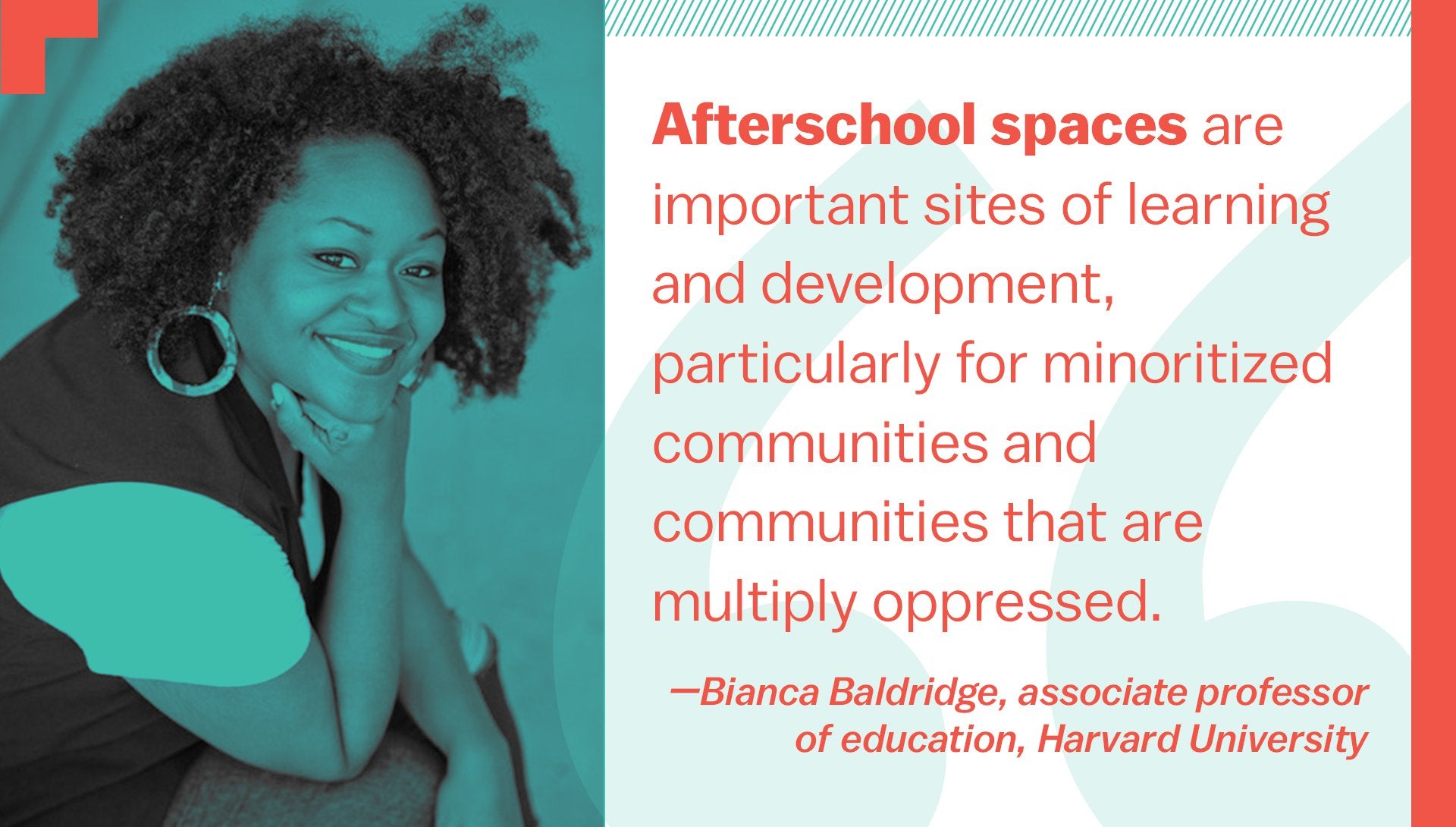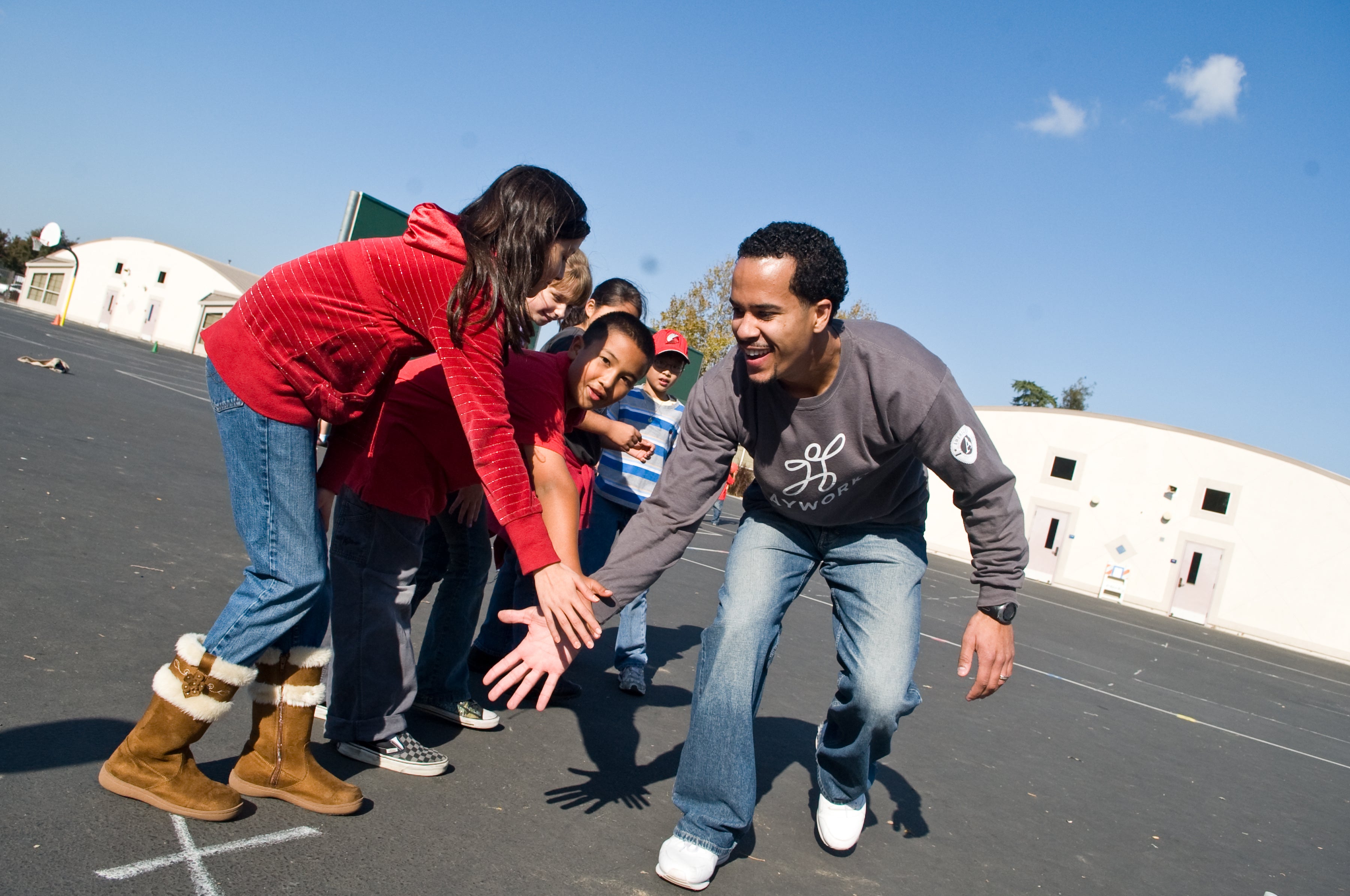One of the best parts of my job as director of research at Wallace is to interact with some of the country’s leading scholars and researchers studying our areas of work: the arts, education leadership and youth development. These folks are so committed to and insightful about their respective fields. It’s maybe no surprise that many of them worked as teachers, youth workers, artists and the like, before entering the research world, and that this is partly what drives their passion.
Since I joined the foundation in late 2019, we have awarded 36 research grants, large and small, to 33 researchers, 14 of whom were first-time Wallace grantees. I thought it would be interesting (and fun!) to start an occasional series of interviews with some of them, as we publish their findings on the Wallace website. Kicking off the series with me is Bianca Baldridge, an associate professor of education at Harvard University. Bianca is a national expert in out-of-school-time programming (OST), with a particular interest in the youth workforce.
In 2020-2021, we commissioned Bianca, along with a group of her colleagues, to produce a rapid evidence review intended to inform Wallace’s future work in youth development. High level takeaways from that study are summarized in this research brief. In addition to a lit review and interviews with experts, their study involved a YPAR (youth participatory action research) project, where a group of older students designed and conducted a research study of their peers involved in afterschool programs, that you can read about here. This work also led to a series of podcasts, where youth researchers discuss key issues related to their experiences in afterschool programs and which will be released later this spring.
This conversation has been edited for length and clarity.

Bronwyn: How did you come to focus on out-of-school-time?
Bianca: I came to this work because I was a participant in youth-work programs as a middle school student and started engaging in youth work as a staff member in high school.
As much as I loved these programs—as a participant and a staff member—and as important as they were in shaping my development, as a Black girl growing up in south-central Los Angeles, I was also troubled by the way programs were making assumptions about who I was. They tended to position themselves as saving me, and that kind of deficit positioning of me, which I consciously felt, was a problem. But I didn’t have the language to name it until I got to college and graduate school and began to study African American Studies and sociology. I started to see how my experiences, and the organizations themselves, had been shaped by the social and political context around them—the broader structures of power like race, class and social-economic policies.
Bronwyn: Over the last several years the OST field has started to more explicitly name the “ecological dimensions” of learning and development—in other words, looking beyond the program to understand how it is situated within a broader context, and how that context shapes what is possible. But the social and political dimensions of that ecology are not often articulated. The focus is more on spaces and places and practices.
Bianca: I’m glad you said that. Families matter, communities, neighborhoods, all of that matters. And if those things matter, then within that ecosystem what’s happening? How do we not name those things?
Bronwyn: That attention to the broader structures of power that shape and constrain possibilities is what we call “a critical lens” in the research world. How do you bring that lens to the study of OST?
Bianca: Afterschool spaces are important sites of learning and development, particularly for minoritized communities and communities that are multiply oppressed. My research agenda has been to think about how young people experience these programs: Black and Latinx young people or racially minoritized people in general. To understand the role of relationships within the programs—among youth, youth workers and staff members. And to try to legitimize and create scholarship that highlights the pedagogy as well as the philosophies of youth workers, as legitimate pedagogues and educators within the educational landscape.
Bronwyn: Can you say more about what you mean about youth worker pedagogy?
Bianca: I find that youth workers often have a true pedagogy in the sense that they have a philosophical sort of understanding about teaching, about learning, about youth development, about engagement with young people, and you can see that in practice in how they actually engage. So how they teach, how they cultivate relationships and connect with young people and their families, how they spark interest and ideas and a love of learning that is not just about academics, but also just about the world in general.
Bronwyn: It sounds like you’ve seen them recognizing the totality of the young person?
Bianca: Yes. Youth workers can support youth academically, emotionally, socially and politically. They are really significant to “whole child” development. Youth workers are often placed in the position where they are supporting young people through their lives in school, neighborhoods and their families. Young people’s identities are complex and youth workers can be instrumental in nurturing all of who a young person is and who they are becoming.
Bronwyn: There has been a lot of research on how social policies and structures affect teachers and schooling, but less on how they impact youth development or afterschool and summer programs. I know you’re currently writing a book about this.
Bianca: Yes, my current research is thinking about how displacement and gentrification can lead to school closures or rezoning, which in turn can impact community organizations that have been committed to Black liberation or youth development within Black communities. Part of the premise for me is that community organizations in many ways can be the backbone of neighborhoods and communities, and I’m really struck with the question of what happens when afterschool programs can’t afford high rents. What happens when they’re moved out of neighborhoods, what happens to programming for young people? Where do they go? Where will they hang out, what will they do?
For youth organizations that are committed to sociopolitical development or critical consciousness, I’m really interested in what they do and how they’re making sense of these transitions and displacement, and how they’re able to maintain a social justice, youth development approach in their work through this change. My new book links Black youth workers to the legacy and traditions of organizers like Ella Baker or Septima Clark, and projects how youth workers approach preparing young people to make sense of the world around them and to navigate a racially hostile, anti-Black world. It also addresses how they navigate anti-Blackness within their profession. How are they simultaneously taking care of themselves and also helping young people to negotiate the same social and political forces?
Bronwyn: Your work has made me think a lot about how much our vision of the best out-of-school-time programs depends on youth workers who are profoundly giving: Giving love, giving respect, giving vision, giving support. But it’s not like there’s a bottomless well of giving if the system is not giving back to them. Your work highlights how the structures that suppress wages, limit benefits and sometimes tokenize youth workers can work to undermine the whole vision for what young people can gain from out of school time.
Bianca: Yes. Because the burnout and the turnover are real. And youth workers are everywhere: detention centers, museums, libraries, housing programs, afterschool organizations. I believe that programs and organizations, however they look, need to be able to meet the needs of the young people in their communities. But we need to think about the youth workers, or the people who care for young people, and find systems and structures that support them.
Bronwyn: The research you and your colleagues did for Wallace, and the research of the youth themselves, really got to how essential building a positive and inclusive context is, and that job is ultimately left to youth workers to create those conditions.
Bianca: What blew us away was hearing directly from the youth about how students feel in those programs. They talked about feeling like things were cliquish or tokenistic. This goes back to what do these programs look like, what do they feel like, how are they organized, how are they structured? Not just anybody can run an inclusive OST program, not just anybody should run a program. I think allowing young people to share their firsthand experiences is just always, always, always sobering.
Bronwyn: I totally agree. There’s been a lot of work done on the kinds of things you need to have in place for assessing or building towards quality programs, but it is outside-in, and not inside-out, in terms of what it actually feels like to be in that space.
Bianca: Yes. And I definitely want to be able to talk about the resistance and the triumphs and the celebrations, the ways in which organizations, youth workers and young people are able to navigate structures outside and inside of the programs. But I think it’s important to name those structures that can oppress and get in the way of the possible. We have to be able to name and understand them to be able to overcome them.



